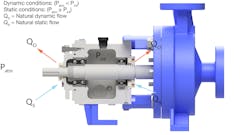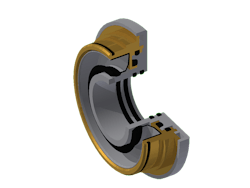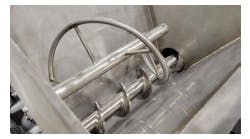Reliability doesn’t happen by accident. If reliable operation is what a plant team strives for, planning for a plantwide lubrication system is a great way to embark on the reliability journey. This concise list outlines critical steps to achieving reliable lubrication, but more can be done to achieve lubrication reliability in a machine.
Choose the ideal lubricant and ensure it gets to the right machine: Installed equipment selected for reliability and maintenance is a way to keep these assets running optimally. This includes the lubricants for each machine. Selecting the best lubricant for an application and its assets is the first step. Viscosity, additives and the equipment’s operating loads, speed and temperature should be considered.
The lubricant also needs to reach the right place. The reliability and maintenance team must color code and label them by type. This helps avoid mixing lubricants in storage and transfer containers. The same care must be taken when labeling the matching points on each asset in which the lubricant is added.
Accurate storage and handling: Quality requires a deliberate process. The storage and handling of lubricants from warehouse receiving to delivery at the machine need a process, as well. When handling lubricants, one broken link in the chain of custody can ruin the whole process.
Lubricants must be tested at receiving to ensure that they meet the defined specifications before they are added to the storage systems. Simple ASTM tests measure the properties and the cleanliness of the fluid. Then they will likely need to be filtered and polished to meet the quality specifications for the equipment. The transfer containers must be clean and sealed to prevent any contamination as the lubricant is transferred to the asset.
Use the correct amount: Too little lubricant is an obvious problem, but more is not necessarily better. Too much oil or grease can be just as destructive to systems. Extra lubricant volumes may hinder oil slinger rings as well as splash lube systems. Excess volume also increases bearing operating temperatures and can blow out oil seals.
Add and change lubricants at the right time: Selecting the right time to replace lubricants is subjective. Accurate timing provides a huge opportunity to improve reliability. Lubricant or oil changes also involve some of the most variability at different plants.
For example, plants may all have the same equipment type in the same operating environments. However, one plant changes the oil every quarter. Another does this once per year. Finally, the last plant changes the oil every three years. Why? With this much variability, more reliability engineers and maintenance managers should be asking this question.
What can go wrong?
If the lubricants enter the machine clean and fit for use and the operating environment is the same, how does the oil become contaminated? The answer lies in either the oil seals, breathers, filters or some combination of these components. Seals, breathers and filters have a finite lifetime. Filter life can be measured, and many breathers have color-changing desiccant to indicate when they need to be replaced.
The function of oil seals is to keep lubricants in and contamination out. Oil leakage can be seen and measured. Discovering contamination, though, is more difficult. However, oil testing for contamination is available and is the only way to know that an oil seal is operating effectively.
Oil seal performance can be measured. Oil analysis reveals how well the seal operates and helps determine functional failure rates. Understanding these failure rates helps teams determine the right time to change the oil. If the oil seals allow many contaminants in and lubricant changes are occurring more frequently, a new oil seal may need to be considered, particularly if simple lip seals are the assets only line of defense.
Case study: Paper goods manufacturer
An East Coast paper manufacturer had an issue with leaking gearboxes and recently replaced its oil seals. The facility, which punches out plates, produces two million plates each day. Downtime costs the plant in production losses and money.
The problem
The reliability team had recently replaced the clear, lower quality lubricant used in its gearboxes with a high-quality synthetic lubricant that was not clear. The oil seals — rubber, spring-loaded lip seals — on the gearboxes leaked this lubricant out of the stuffing box, causing a housekeeping nightmare.
Since the high-quality lubricant cost much more than the original, this lubricant loss was expensive, in addition to being messy. The reliability engineer’s supervisor said that they needed a better sealing solution if they wanted to use the more expensive lubricant.
The team also had to frequently change the felt roll that delivered paper to the stamper because the lubricant, no longer clear, leaked onto the roll. This would have changed the color of the paper if they did not change the roll. With the leakage mess and the costs associated with the high-quality lubricant and roll-changing downtime, the reliability engineer knew the team needed a better seal solution.
The solution
After thorough research, the facility’s reliability engineer chose a non-contact, labyrinth bearing isolator specifically designed for gearboxes (see Image 2). With non-contact, compound labyrinth bearing isolators, oil changes because of contamination may be minimized and, in some cases, eliminated. The design, with expeller technology, forces contaminants out of the seal with centrifugal force. They are moved away from the bearing and lubricant and out of the gearbox.
The chosen bearing isolator seals during dynamic and static situations. Under dynamic conditions, the housing vents to the atmosphere because it is at a higher temperature and pressure than the atmospheric side. Sealing against contaminants, however, is not as difficult.
One of the most challenging sealing situations is when a gearbox is static or shut down. In this state, contaminants may enter the bearing housing. A typical housing interacts with the surrounding environment by always attempting to achieve equilibrium (see Image 3 of a pump bearing housing; gearboxes experience this same interaction).
When the machine shuts down, the internal housing cools. Because cool air is denser than warm, the bearing housing will consume the air that is inside and draw air from the atmospheric side as it moves to equilibrium. With the external air, moisture and dust travel into the housing.
As the contacting O-rings of traditional isolators wear, even more contaminants may enter the housing, and therefore the lubricant. Contaminants will continue to migrate into the bearing housing during shutdown unless the seal is replaced, or a different design is chosen.
With the seal selected by the reliability engineer, the bearing housing still takes in air under static conditions. In contrast to traditional isolators, as airborne contaminants and vapor enter, the non-contact bearing isolators chosen by the paper plate manufacturer break down the contaminants’ energy. This is because they are forced through a series of vertical, throttling gaps (see Image 4). There, contamination is captured within the internal condensate trap. It drains out of the gear box through a small static weep hole.
Each gear box at the plant requires two bearing isolators. With this seal installed initially on one of the 68 gear boxes (see Image 5), the team tested the success of the seal. Since this first bearing isolator was installed, the team at the paper plate manufacturer has replaced the oil seals on about 20 gearboxes. The team plans to replace the remainder throughout the rest of the year.
These replacement bearing isolators have been a success. They solved the housekeeping and leakage issues. They also prevent the work hours and downtime associated with replacing the felt roll.
Chris Tindell, CMRP, is a regional business manager for Sealing Equipment Products Co., Inc. (SEPCO). A reliability leader in the fluid sealing industry, SEPCO supports global distribution in more than 30 countries. Tindell is a maintenance and reliability professional with more than 20 years of experience in reliability consulting, training and troubleshooting equipment. He is an experienced vibration and lubrication analyst and maintains professional certifications in multiple engineering technology fields. Tindell has worked in many manufacturing industries auditing and optimizing PSM maintenance programs and providing training on RCM and lean manufacturing strategies. He may be reached at [email protected].
David Brewer is regional manager, Atlantic Region, for SEPCO. Before this role, he served four years in the U.S. Navy and received three Letters of Commendation. He began his career in the fluid sealing industry in January 1995 with AW Chesterton. Brewer later became Virginia regional manager for John Crane until he joined the SEPCO team. He has served many industries including pulp and paper, chemical processing, food and beverage, power generation, textile and waste treatment. He graduated from Lees McRae College. He may be reached at [email protected].






